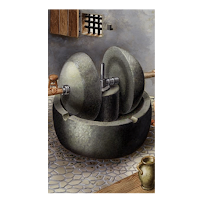We have learned a lot about the harvest of olives and the production of olive oil through written records, archaeology, and art. Many of these practices are largely unchanged. We do know that wild olives were not harvested for the most part; however, they were used for making perfume and to crown the olympic victors.
What the olive will be made into depends on how ripe it is. This still holds true today. Before the olives are ripe some are harvested to produce the highest quality oil named
Omphakinon. After another month more olives are harvest that will be made into regular oil. Once the rest of the olives were fully ripe they were harvested.
Harvesting was done by one of three ways:
- Hitting the branches with something
- Picking the ripe olives up off the ground
- Plucking the olives by hand
These are the same methods used for harvesting today. In terms of oil production it is fairly simple, and with the exception of advances in presses as remained very similar. After harvesting the olives have to be crushed. This could be done by hand or use a
Trapetrum (A vessel with 2 semi spheres and and they use
rotational force to efficiently crush the olives.) After this is done you press the olives. After multiple pressing the resulting by product is called
amurca. This could be used as a pesticide or fuel.
Source:
Perdicoulias, Panaghiotes.
Museum of the Olive and Greek Olive Oil: A Guide. Athens: Piraeus Bank Group Cultural Foundation, 2007. Print.
Source: Source:
These images show the harvesting process and a drawing of a Trapetrum.


No comments:
Post a Comment